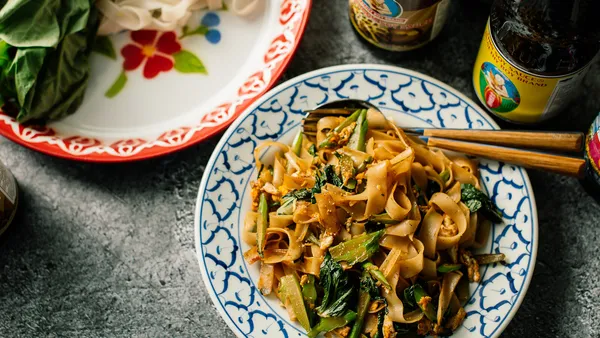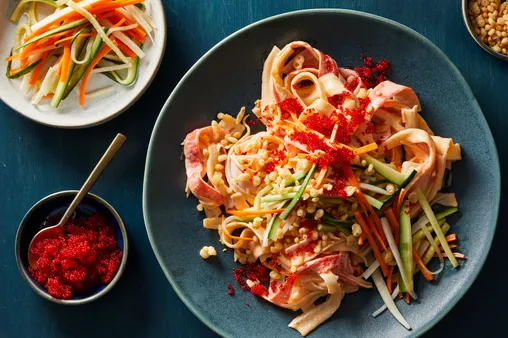Table of Contents
The art and science of making Thai noodles is a complex and fascinating process that has been passed down through generations. From the selection of the right ingredients to the precise cooking methods, every step is essential to creating the perfect noodle dish. At Tauhuichiban, we are passionate about Thai noodles, and we believe that everyone should have the opportunity to enjoy their delicious and authentic flavors. In this article, we will explore the art and science behind Thai noodles, from the history and origins of the dish to the different types of noodles and their uses. We'll also discuss the health benefits of Thai noodles and how to enjoy them in a variety of ways.
I. The Art of Making Thai Noodles: A Delicate Balance of Tradition and Technique
The art of making Thai noodles is a complex and fascinating process. From the selection of the right ingredients to the precise cooking methods, every step is essential to creating the perfect noodle dish. This article explores the art and science behind Thai noodles, from the history and origins of the dish to the different types of noodles and their uses. We'll also discuss the health benefits of Thai noodles and how to enjoy them in a variety of ways.
Thai noodles are a staple of Thai cuisine, and they are enjoyed all over the world. They are made from a variety of ingredients, including rice, wheat, and eggs, and they can be cooked in a variety of ways. The most popular types of Thai noodles include:
- Rice noodles: These noodles are made from rice flour and water, and they are the most common type of noodle used in Thai cuisine. Rice noodles are thin and delicate, and they have a slightly chewy texture.
- Wheat noodles: These noodles are made from wheat flour and water, and they are thicker and chewier than rice noodles. Wheat noodles are often used in stir-fries and soups.
- Egg noodles: These noodles are made from wheat flour, eggs, and water, and they have a slightly yellow color. Egg noodles are often used in soups and curries.
The different types of Thai noodles can be used in a variety of dishes, including:
- Pad Thai: This is a popular Thai dish made with stir-fried rice noodles, vegetables, and a sweet and sour sauce.
- Tom Yum Goon: This is a spicy and sour soup made with shrimp, mushrooms, and lemongrass.
- Khao Soi: This is a northern Thai dish made with egg noodles, curry paste, and coconut milk.
Thai noodles are a healthy and delicious way to enjoy a variety of Thai dishes. They are a good source of carbohydrates, protein, and fiber, and they are also low in fat. Thai noodles can be enjoyed as a main course or as a side dish, and they can be easily customized to your own taste preferences.
Here are some tips for making the perfect Thai noodles:
- Use the right ingredients. The quality of your ingredients will have a big impact on the flavor of your noodles. Be sure to use high-quality rice flour, wheat flour, or eggs, and fresh vegetables.
- Cook the noodles properly. The cooking time for Thai noodles will vary depending on the type of noodles you are using. Be sure to follow the package directions carefully.
- Season the noodles to taste. Thai noodles can be seasoned with a variety of sauces and spices. Be sure to taste the noodles as you cook them and adjust the seasonings to your own taste preferences.
With a little practice, you can master the art of making Thai noodles. So next time you're in the mood for a delicious and healthy Thai meal, give Thai noodles a try.

The Art of Making Thai Noodles: A Delicate Balance of Tradition and Technique
II. The Science of Thai Noodles: Understanding the Chemistry Behind the Craft
When it comes to Thai noodles, the science behind their creation is just as fascinating as the flavors they deliver. The chemistry involved in making these beloved noodles involves a delicate balance of ingredients and techniques, each playing a crucial role in achieving the perfect texture, taste, and aroma.
Ingredient | Role in Noodle Making |
|---|---|
Rice Flour | Forms the base of most Thai noodles, providing structure and chewiness. |
Water | Hydrates the flour and helps develop the dough's consistency. |
Salt | Enhances flavor and strengthens the gluten network. |
Alkali (e.g., kansui) | Adds elasticity and alkaline flavor to the noodles. |
Xanthan Gum | Acts as a stabilizer, preventing the noodles from becoming too fragile. |
The process of making Thai noodles begins with mixing the ingredients to form a dough. The dough is then kneaded and rested to allow the gluten to develop, which gives the noodles their characteristic elasticity. The dough is then rolled out into thin sheets and cut into the desired noodle shape.
The cooking process also plays a crucial role in determining the noodles' texture. Noodles are typically boiled in water until they reach the desired doneness, which can vary depending on the type of noodle. Overcooking can result in mushy noodles, while undercooking can leave them too chewy.
By understanding the science behind Thai noodles, we can appreciate the intricate processes involved in creating these culinary delights. From the careful selection of ingredients to the precise cooking techniques, every step contributes to the unique and captivating experience of enjoying a bowl of authentic Thai noodles.

The Science of Thai Noodles: Understanding the Chemistry Behind the Craft
III. Mastering the Techniques: Essential Skills for Crafting Authentic Thai Noodles
The art of making Thai noodles is a complex and fascinating process. From the selection of the right ingredients to the precise cooking methods, every step is essential to creating the perfect noodle dish. In this section, we will explore the essential skills and techniques that you need to master in order to craft authentic Thai noodles.
One of the most important aspects of making Thai noodles is the selection of the right ingredients. The type of flour used, the water content, and the addition of other ingredients such as eggs or salt can all affect the final texture and flavor of the noodles. It is important to use high-quality ingredients and to follow the recipe carefully in order to achieve the desired results.
Once you have selected the right ingredients, the next step is to prepare the dough. The dough should be kneaded until it is smooth and elastic. The kneading process helps to develop the gluten in the flour, which gives the noodles their characteristic chewy texture. Once the dough is ready, it can be rolled out into thin sheets and cut into noodles.
The cooking method used for Thai noodles can also affect the final texture and flavor of the dish. Noodles can be boiled, steamed, or fried. The boiling method is the most common, and it results in noodles that are soft and chewy. Steaming results in noodles that are more tender, while frying results in noodles that are crispy and flavorful.
No matter which cooking method you choose, it is important to cook the noodles until they are al dente. Al dente means that the noodles are cooked through but still have a slight bite to them. Overcooked noodles will be mushy and lack flavor.
Once the noodles are cooked, they can be served with a variety of sauces and toppings. Some of the most popular Thai noodle dishes include pad thai, khao soi, and boat noodles. Each dish has its own unique flavor profile, and you can experiment with different combinations of sauces and toppings to find your favorite.
Making Thai noodles is a rewarding experience, and it is a great way to learn more about Thai culture and cuisine. With a little practice, you can master the essential skills and techniques needed to create delicious and authentic Thai noodles.
Noodle Type | Ingredients | Cooking Method |
|---|---|---|
Sen Chan | Rice flour, water, salt | Boiled |
Sen Lek | Rice flour, water, salt, egg | Boiled |
Sen Yai | Rice flour, water, salt, egg | Boiled |
Wun Sen | Glass noodles | Soaked in hot water |
Khanom Chin | Rice flour, water, salt | Steamed |
Here are some additional tips for making authentic Thai noodles:
- Use a high-quality rice flour. The quality of the flour will affect the texture and flavor of the noodles.
- Knead the dough until it is smooth and elastic. The kneading process helps to develop the gluten in the flour, which gives the noodles their characteristic chewy texture.
- Cook the noodles until they are al dente. Al dente means that the noodles are cooked through but still have a slight bite to them. Overcooked noodles will be mushy and lack flavor.
- Experiment with different sauces and toppings to find your favorite Thai noodle dish.
With a little practice, you can master the essential skills and techniques needed to create delicious and authentic Thai noodles.

Mastering the Techniques: Essential Skills for Crafting Authentic Thai Noodles
IV. Exploring Flavorful Variations: The Regional Diversity of Thai Noodles
Thai noodles come in a wide variety of shapes, sizes, and flavors, each with its own unique regional flair. From the spicy and sour tom yum noodles of central Thailand to the sweet and savory khao soi of the north, there's a Thai noodle dish to suit every palate.
Northern Thailand: The noodles of northern Thailand are typically made from wheat flour and are often served in a broth. Khao soi is a popular noodle dish from the north, made with egg noodles, a spicy curry broth, and crispy fried onions. Another popular northern noodle dish is khao piak, a rice noodle soup with a mild broth and a variety of toppings such as pork, chicken, or fish.
Central Thailand: The noodles of central Thailand are typically made from rice flour and are often served in a stir-fry or soup. Pad Thai is a popular noodle dish from central Thailand, made with stir-fried rice noodles, shrimp, chicken, and vegetables in a sweet and savory sauce. Another popular central Thai noodle dish is tom yum noodles, a spicy and sour soup made with rice noodles, shrimp, mushrooms, and herbs.
Southern Thailand: The noodles of southern Thailand are typically made from either wheat flour or rice flour and are often served in a curry. Gaeng keow wan is a popular noodle dish from the south, made with egg noodles, a green curry broth, and chicken or beef. Another popular southern Thai noodle dish is khanom jeen, a rice noodle dish served with a variety of curries and toppings.

Exploring Flavorful Variations: The Regional Diversity of Thai Noodles
V. Conclusion
Thai noodles are a delicious and versatile dish that can be enjoyed in a variety of ways. They are a staple of Thai cuisine, and they are becoming increasingly popular all over the world. The art and science of making Thai noodles is a complex and fascinating process, and it is one that has been passed down through generations. In this article, we have explored the history, origins, and different types of Thai noodles. We have also discussed the health benefits of Thai noodles and how to enjoy them in a variety of ways. We hope that this article has given you a better understanding of the art and science of making Thai noodles.